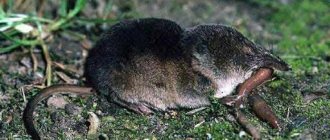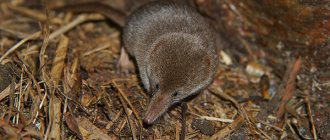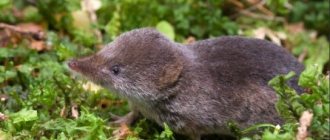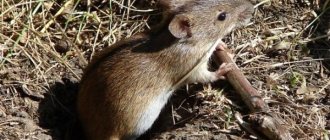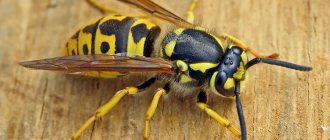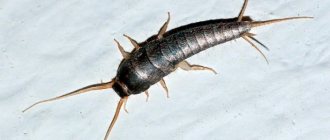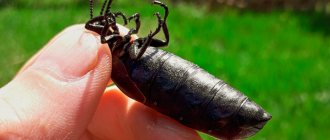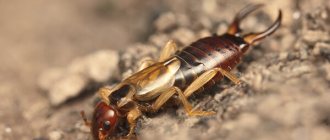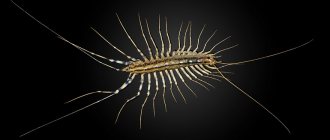The shrew is a fairly small animal belonging to the shrew family. This insectivore lives on almost all continents (except the northern ones), preferring to choose forest zones and tundra as its habitat. It is among the shrews that one can find the smallest and most voracious mammals - there are about 7 dozen species in this genus - almost two dozen of them live in Russia.
Description of the shrew
Externally, shrews resemble mice. The length of their elongated body is 6-8 cm, weight is about 8-15 g, the tail is relatively long from 3 to 5 cm. The head is a cone-shaped head, ending with a thin long movable proboscis, the teeth are brown or reddish. On the sides and back the fur is thick, velvety, brownish or dark brown in color, the belly is light gray. The ears look like small flaps that protrude slightly above the fur.
Benefits and harms
Shrews are beneficial because, thanks to their fast metabolism, they are able to feed up to 80 times a day and destroy many harmful insects. In summer, animals cannot live longer than 11 hours without food. In a day they are able to consume an amount of food that exceeds their weight by 6 times. An adult shrew eats at least 15 grams of insects per day.
Unfortunately, the harm from the life of this cute animal outweighs the benefits. With its long trunk, the rodent digs up the soil, gnaws root crops, and damages the root system of tomatoes and peppers. Plant seeds are also eaten. Therefore, fighting them on the site often becomes important for gardeners.
Feeding characteristics of shrews
— Advertising —
Shrews are carnivorous mammals. They spend almost all their time searching for food. They cannot live even three hours without food. This is due to intense metabolism and rapid digestion of food.
The shrew's diet includes earthworms, insect larvae and pupae, butterflies, and dragonflies. In addition, it also hunts animals such as mouse-like rodents and frogs. In winter, the food is monotonous, since under the snow in the unfrozen soil layer the shrew can only find wintering insects. Once in cellars and pantries, the shrew never touches food supplies; it only looks for insects.
Plant food can serve as a supplement to the shrew's main diet, especially in winter, for example, seeds of spruce and pine cones, linden nuts.
What does it eat?
In searching for food, the shrew is helped by a highly developed sense of smell and very sensitive hearing (even with the use of echolocation). The basis of her diet is animal food - this is understandable, because such proteins are the most high-calorie. The shrew feeds on everything it can catch with its needle-sharp teeth. Moreover, the amount of food that a shrew consumes per day can be several times greater than the entire animal itself.
A shrew (for example, its species is the tiny shrew) can feed an insane number of times throughout the day - more than a hundred - while eating every half hour.
Shrew distribution
The shrew is found throughout Eurasia from the shores of the Pacific to the Atlantic Ocean, south to Palestine and to Siberia in the north.
— Advertising —
The animal lives in various areas, but always in damp and shady areas. Lives in forests, parks, meadows. In cold seasons, it enters populated areas and hides in storerooms and cellars.
Interesting Facts
One interesting fact is known about the shrew. It is due to the fact that its smallest species live precisely where the harshest living conditions occur - the tundra, highlands, Siberia - and, logically, should strive for more favorable territories. Moreover, the size of the animal can be smaller the further north it lives - which contradicts Bergman’s rule, according to which the size of individuals should change upward due to cold. Many shrews in the northern regions are able to reduce the size of their internal organs during the winter in order to reduce heat loss.
Common types of shrews
- Common shrew or common shrew or wood shrew (Sorex araneus)
Body length 55-82 mm, weight from 4 to 16 g. Tail 60-75 mm long.
The body is dark brown on top, almost black-brown, the abdomen is light. The young are light brown. The tail is bare or slightly pubescent. The ears are almost invisible. The muzzle is narrow, elongated. The species is distributed in northern Europe in dense grassy thickets, forest undergrowth, bush thickets, and heather heaths.
- Tiny shrew or Chersky's shrew (Sorex minutissimus)
The smallest species with a body length of 4-5 cm, a tail length of 2.5-3 cm. Weight is about 4 g. The head is wide and large, ending with a short proboscis.
The eyes and ears are small. The fur is short, velvety, dark brown or brown on the back and gray or silvery-white on the belly. The tail is also dark above and light below. The species is found in the west from the Scandinavian Peninsula to Japan and Sakhalin in the east.
- Tibetan shrew (Sorex thibetanus)
The body length is 51-64 mm, the tail is 32-54 mm long. Outwardly similar to an ordinary shrew.
The species was discovered in China, in the provinces of Qinghai, Sichuan and Gansu.
- Bukhara shrew (Sorex buchariensis)
Body length 55-69 mm. The tail is 42-50 mm long with a tassel at the tip. The back is painted sandy brown or light brown. The belly is light gray. The head is elongated and narrow.
The species' habitat includes Uzbekistan, Tajikistan, and Kyrgyzstan, where it lives in high-mountain birch and poplar forests.
- Medium shrew (Sorex caecutiens)
Body length is from 58 to 77 mm, tail length is 36-42 mm, weight is 4-8.5 g. The back and sides are brown to dark gray, the belly is grayish-white.
Distributed from Finland, northern Sweden and Norway to the Anadyr River basin. Also found on Sakhalin (Russia) and Hokkaido (Japan), in Korea.
- Gansu shrew (Sorex cansulus)
Body length 62-64 mm, tail 38-43 mm long. The back is grayish-brown, the belly is reddish-fawn. The tail is dark brown above, light below.
A rare species that lives in the south of the Chinese province of Gansu.
Large-toothed shrew or dark-toothed shrew or dark-toothed shrew or dark-toothed shrew or large-toothed shrew (Sorex daphaenodon)
Body length is 61-71 mm, weight reaches 9.5 g. The proboscis is short. The back is dark brown or black, the sides are light, and the belly is dark gray. The tail is brown.
Distributed from the Urals to Sakhalin.
- Giant shrew (Sorex mirabilis)
One of the largest species with a body length of up to 10 cm and a weight of about 14 g. The body is brownish-brown in color, the belly is lighter and dull.
Muzzle with long light gray whiskers. Endemic to the Far East, where it lives in the south of the Primorsky Territory, northeast China and the north of the Korean Peninsula. Listed in the Red Book of Russia.
- Equal-toothed shrew (Sorex isodon)
Body size is average. The fur color is dark, monochromatic, the fifth upper intermediate tooth is brightly pigmented.
It is found in the taiga of Eurasia from the Scandinavian Peninsula and Belarus to the Pacific coast. Included in the Red Books of the Republic of Karelia and the Moscow Region.
- Kozlov's shrew or Tibetan mountain shrew (Sorex kozlovi)
Body length is about 41 mm, tail length up to 33 mm. Summer fur is long, fluffy, silky. The tail is pubescent with a tassel at the tip. The back is chocolate-brown in color, the sides are light, the belly is white with a fawn coating.
A rare species, was discovered in Tibet.
- Little shrew or small shrew or little shrew (Sorex minutus)
Body length 43-64 mm, tail length 31-46 mm.
Weight from 2.5 to 7.5 g. The back is brown-gray or reddish-coffee. The belly is grayish-white, rarely yellowish-fawn. Winter fur is darker. The hair on the tail is thick and long. The proboscis is sharp, elongated. Distributed in Europe, the European part of Russia, in the west and south of Siberia, in Kyrgyzstan.
- Clawed shrew (Sorex unguiculatus)
Outwardly it resembles a common shrew.
Body weight reaches 20 g, body length 54-97 mm, tail length 40-53 mm. Lives in China, Japan, Russia.
- Kamchatka shrew (Sorex camtschatica)
Body length is about 57 mm, tail 54 mm long.
Weight about 5 g. The back is earthy-gray, the sides are light, brown or fawn. The belly is light gray. The hind foot is very elongated. The species is distributed in the northeast of Siberia, in Kamchatka.
- Masked shrew (Sorex cinereus)
The body length reaches 9 cm, including 4 cm of tail length, weight up to 5 g. The fur is gray-brown on top, light gray below, the muzzle is pointed. The tail is brown above, lighter below, and the tip is dark.
Found in Canada and the USA.
- Long-tailed shrew (Sorex dispar)
The medium-sized shrew is gray in color with a light belly, a pointed muzzle and a long tail.
It lives in North America, in the forests of Canada and the USA.
- Little shrew (Sorex hoyi)
Body length is up to 5 cm, tail is about 2 cm, weight is 2-2.5 g. The fur is gray-brown or red-brown, the belly is light.
In winter, the fur turns gray. This is the smallest mammal in North America, lives in Canada and the USA, in coniferous and deciduous forests.
- Paramushir or Beringian shrew (Sorex leucogaster)
Outwardly it resembles an ordinary shrew.
It is endemic to Paramushir Island (Kuril Islands).
- Marsh shrew or water shrew (Sorex palustris)
Body length up to 15 cm, tail length about 8 cm, weight up to 13 g. The back is dark gray, the belly is light.
Found in Canada and the USA.
Habitat
You can meet shrews almost everywhere; often more than three species of these animals live simultaneously in one area. For example, in the Moscow region there are as many as six species of shrews: common shrew, small and medium shrew, tiny shrew, equal-toothed shrew and shrew.
Equal-toothed ones are found along creeks and river banks, just like the common shrew - they are big lovers of dampness. The medium and tiny shrews are among the rarest species, preferring coniferous and taiga forests. The small shrew and common shrew live in open areas - in steppes, meadows, and woodlands.
The shrew is unpretentious in terms of comfortable living conditions, but an abundance of food all year round is a necessary condition for it. It is not possible for a small animal to travel long distances in search of food, and it is not able to survive without food for more than 3-4 hours.
Shrew behavior
Shrews are very energetic animals and are nocturnal. During the day they search for food only near shelters. They hunt on the ground, sometimes climbing out onto low-growing grasses and shrubs. They move very quickly, jump 10-15 cm. They do not hibernate, and in winter they continue to actively search for food. At this time they live in deep drifts.
Reproduction of shrews
Shrews build nests in the top layer of soil, stumps or old burrows of other species from dry parts of herbaceous plants, and line them with moss on the inside.
The breeding season begins at the end of March and continues throughout the warm season. Females produce 2-3 broods, 7-8 babies in each. Pregnancy lasts 18-28 days. Shrews are born helpless, naked, blind, but they grow quickly and already at the age of 1 month they feed like adults.
Life expectancy is about 1.5 years.
Natural enemies
The tiny little thing, foul-smelling and very evil, oddly enough, also has its enemies:
- small predators;
- predator birds;
- snakes and vipers;
- predatory fish;
- representatives of their own species;
- parasites.
It is interesting that when studying the common shrew, more than one and a half dozen species of various parasites and helminths were found in its representatives. One individual could contain more than 500 worms.
Usually the shrew is not bothered by people - although sometimes they can suffer in the event of mass persecution of rodents. Most often, people harm it indirectly - through changes in the habitat (development, deforestation, etc.).
